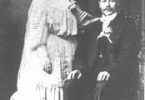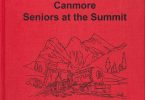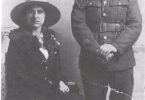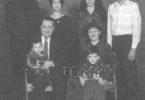The day I had arranged to meet Elizabeth (Liz) Blackwood started out badly. It had snowed the night before and the roads were treacherous. As I gingerly drove to keep our appointment, my usually reliable Toyota showed signs that something ominous was happening under its hood; and, to crown it all, I got lost. But when this flustered, preoccupied interviewer finally located Liz’s apartment in Bow Valley Lodge, she discovered that a few hours spent with this long-time Canmore resident was the best cure for the Monday morning blues she had ever found.
My first glimpse of Liz Blackwood’s world revealed a veritable Aladdin’s Cave. Dominated by a picture window with a backdrop of the mountains that included the peak known as Squaw’s Teat, the living room was home to an amazing collection of dolls, stuffed animals and quirky curios. Instant conversation pieces, each one. I was quickly introduced to Clementine, the Klondike Doll, the Calgary Cowgirl, Delta Dawn, Ruby Don’t Take Your Love to Town, Anne of Green Gables, a Japanese karate doll complete with gong, and Irish Leprechaun, bought with coupons from Irish Spring soap, which has been displayed for many years in Marra’s Grocery on St. Patrick’s Day; dolls from many other ethnic backgrounds; dolls that play hockey, baseball, tennis; angel dolls; dolls that wind up and play tunes …. I lost count. Whilst all of the dolls were beautiful, the lowest common denominator of the other occupants of the room was ugly or fun. There was Alf, the Alien Life Form, Ugly Baby, the Abominable Snowman, to mention but a few. Some of them were called upon to do their party piece; a talking Christmas tree introduced himself, “Hello, I’m Douglas Fir,” and sang a Christmas carol; a telephone greeted the caller with, “I want to hold your hand,” and a drumset alarm clock regaled us with a drum roll.
Liz is eight-two years young. The quintessential extrovert, she embellishes her reminiscences by frequently bursting into song (she has a strong country voice); by quotes from Robbie Burns; and with verses from the many poems she has penned Herself.
She has been collecting the dolls seriously for the past six years. “They are company for me,” she remarks. Each one has two names; the name of the doll and the name of one of her children, grandchildren, step-grandchildren and great-grandchildren who will eventually inherit them. They represent a concrete form the precious personal moments Liz has shared with each member of her large extended family. Pride of place in the collection goes to Beauty given to her by her youngest son, Nick, thirty-two years ago Liz found the Beast to complete the duo several years ago at Disneyland. Special mention was made of Matthew, the doll given to her by her eldest son, who died of cancer two years ago.
The members of her family have been contributing to the collection, buying her a different, usually eccentric, stuffed animal every Christmas. Liz jokingly remarks that her family thinks she is in her second childhood.
The first seeds of the doll collection were sown seventy years ago when Liz, living in Ayrshire, Scotland, with her parents, was given her first doll for her twelfth birthday. It was a baby doll with cloth body, porcelain head, arms and feet. When her sister was born that summer, an aunt arrived with her son to help out. Unfortunately, Liz’s cousin smashed the doll to smithereens. Unknown to Liz, her father sat up night after night painstakingly gluing the doll back together again, even ensuring that its eyes opened and closed. He covered the cracks in the porcelain with pieces of his wife’s fur coat. Liz’s mother also got into the act, crocheting a little hat for the doll, and her parents presented it to her on her thirteenth Birthday.
Liz Lochore Bain eloped to Gretna Green to marry John Blackwood when she was eighteen. The couple had eight children, three of whom died at birth. She arrived in Canada by boat in 1954, aged thirty-five, with four of her children: John, Alexandra (Sandra), Elizabeth and James Nicholas (Nick). Her husband and eldest son (George) had emigrated the year before. Liz recalls that the journey from Scotland, south to Southampton and onward to Quebec, was a big
experience. She vividly remembers her children queuing up for the boat, each one clutching a little overnight suitcase. There followed a five day train journey across Canada to Mercoal, a coal mining camp near Edson.
The family lived in a log cabin in the camp. It was heated by a wood stove and water had to be hauled from the creek. Four nephews also arrived from Scotland and a garage was converted into a huge bedroom. Although there was great camaraderie among the occupants of the mine site and sick for her native Scotland. She wrote a poem, “The Emigrant’s Lament”, which was published in “The Advertiser”, the local paper back in Ayrshire. Reference in the poem to the dilapidated state of a local landmark, Tibbie’s Brig, sparked a campaign to have it repaired.
The promise of work in diamond mines in the Three Sisters brought the family to Canmore five years later. But their journey was marred by the escape of a dangerous prisoner from Ponoka jail (a man who had killed his family). Their train was held up for eight hours and they arrived too late to get the job.
Homeless and jobless in Canmore in 1959, Liz recalls that the family was warmly received in the town. People were extremely friendly and welcoming. She singles out Cardo Marra, founder of Marra’s Grocery store, for particular praise. He let her run up a bill for one month until her husband got his first paycheque. He also gave the family a turkey every Christmas. He was one of those special people who would help anybody. Her daughter, Liz Fisher, has been working at Marra’s for the last twenty-five years.
The family’s first residence in Canmore was in one of the cabins down by Policeman’s Creek, owned by Jack Anderson and his wife, who were also extremely kind to the struggling family, giving them considerable leeway with rent payments. The site of the cabins is now the Bow Valley Motel. Pete Seminoff’s house and cabins were across the creek in the area now occupied by the Drake Inn.
The conditions in the cabins were primitive. There was no running water; there were two showers, one for the men, the other for the women, and four toilets. There was a common laundry which later was turned into a laundromat by Thelma Anderson and Cross Crowe. It still operates on the same site on Main Street. Incidentally, Liz’s great-nephew, Ian Blackwood, is shareholder/ partner in the Drake Inn and the Rose and Crown.
The family settled into life in the Bow Valley, and over the years, through marriage, have ended up related to most of the old families in Canmore. Liz has twelve grandchildren (a grandson, Matthew Blackwood, killed in a car accident at age seventeen and half); three step-grandchildren and fourteen great-grandchildren.
In his first year in the Valley, Liz’s husband worked for Rockwool and then held a government job until his retirement twelve years later. He died in 1983, aged seventy-three. John and Liz were living testament to the old adage – opposites attract. John, former army chef, was quiet and reserved. Liz is a dynamo.
Liz was employed seasonally at Phil’s Pancake House in Banff and at the Voyageur before securing a position with the Banff Centre. She initially worked as a housemaid, but then enjoyed considerable success as salad chef and creative designer of finger foods. Liz worked for fifteen years, living in Singing Pines, across from the Eric Harvie Theatre, in housing provided by the Centre. Liz and John moved to the Bow Valley Lodge nineteen years ago, the longest time she has ever lived anywhere.
Pointing out that when they moved to the valley all of the buildings on Main Street were family
homes, except for the Canmore Hotel, Marra’s and the Mountainview Grocery Store. Liz decries the recent developments. She refers to the “green eyes” syndrome – those locals who have put material gain ahead of quality of life. She contends that the newcomers in the valley have shown disregard for the lifestyle and wishes of the long term residents. She refers specifically to the renaming of Chinaman’s Peak to Ha Ling Peak on the grounds that the former title was considered derogatory. Liz points out that the Chinese residents chose the name themselves to mark the accomplishment of one of their people. She also decries changes to the by-law on the maximum height of buildings; unnecessary development in wildlife corridors and building in potentially dangerous former mine sites. “It gets Scottish blood up” she avers.
Always called to do ‘a turn’ at local parties and dances, Liz is famous for “Little Red Hen” complete with actions; her repertoire also includes Scottish ballads and country songs. Accompaniment on past occasions has been provided by Vic Lewis and Louie Trono. She was also a leading light in the annual Burns Night celebrations for many years when she would recite the “Ode to the Haggis” whilst performing the ritual cutting of the haggis, cloth over arm. Liz retains her singing voice with one limitation – she can’t hit the high notes anymore. Always the comedienne, when faced with this obstacle, she just stands on a chair!
A poet in her own right, she has commemorated several family, local, and historic occasions
in verse. One particularly interesting anecdote occurred during the 1960s in Banff. Liz heard a lone bagpiper practising for the arrival of Princess Margaret at the Banff Springs Hotel. Reminded poignantly of her native Scotland, she wrote “The Piper on Tunnel Mountain Lookout” which was published in the “Hoodoos Highlander”, the local newspaper, which preceded the “Canmore Leader”.
A member of the New Life Church, Liz’s poems about fellow church members, especially the children, written on their birthdays, has earned her the title “Birthday Gran”. Her sons, Nick and John, have inherited their mother’s creativity. Nick, who has a good singing voice and plays the guitar, is in much demand locally at weddings for his personalized songs dedicated to the bride and groom. John was cartoonist for the “Hoodoos Highlander”.
Asked to reveal her secret for a long and happy life, Liz refers to her belief in God which has helped her through the tragic times – death of her grandson in a car accident; serious illness in the family; death of her husband and eldest son. Although she is blessed with a great sense of humour, her inquiring mind looks for the reasons behind adversity, accepting philosophically that all is part of God’s plan. She believes that it was God’s providence that three of her children died in infancy. Otherwise, she could never have come to Canada, which has given the family such a good life.
And perhaps the essence of Liz Blackwood: “There is no generation gap in our family”, she declares. To illustrate this point, she turns to John McKnight, one of her grandchildren who had since joined us “John, hit the floor”, she says. The young man hits the floor. Immediately, one of the stuffed animals, one that I hadn’t noticed before, a black monkey perched opposite me, started doing the macarena. Liz and John start dancing. It is a magic moment. The hilarity is infectious. I get up and join them. Moving vigorously to the rhythm of the dance, Liz remarks with a grin, “I just boogie with the kids.”
Liz and her extended family had a big gathering of the clans to welcome in the millennium, complete with bonfire, barbecue and fireworks. The event, which was organized by Alana and Gerhardt Faupel, was held in a marquee across from the library. All of the generations were there. To make the celebration even more memorable, a baby girl, granddaughter of Alana and Gerhardt, was born into the family on New Year’s day. Sarah Gerhardt Faupel made her entrance at 11.16 am She was 5 1/2 weeks early and had to be delivered in Calgary. “I never thought I would live to see the year 2000,” Liz beams. “It was a great party”
AN EMIGRANT’S LAMENT
Written by Elizabeth Blackwood (nee Bain)
September 1954, during a fit of dire hameseekness.
Printed in the Murkirk Advertiser and Douglasdale Gazette
I’ve wandered faur frae Scotland’s shore
O’er seas I chosetae dear
But oh! Can I prevent ma thochts
From ever turning home?
I oft times think o’days gone by
Of spots I hold sae dear,
Of childhood frien’s and family,
My memory keeps them near.
Of picnics that, wi’ neebor’s bairns
We gaed oot tae the Ha’,
Tae Tibbie’s Brig cauld water spoot
Brig Twenty ane an’ a’.
I’ve paddled in the watter Ayr
The Greenock water tae,
And cycled tae the auld White Brig
Tae dook, aye money a day.
In courtin’ days there’s mony a walk
Aroon Muirkirk I’ve taen.
The Miller’s Road, the Pooderhoose,
And doon by Tam Rae’s lane.
The walk aroond by Aulkhooseburn
A favorite was o’mine.
On Sundays, doon the Cumnock Road,
My lad’s hand holding mine.
We didna hae a radio
Ne’er dreamed aboot TV
But money a happy nicht I’ve spent
Wi friens and family.
Oft gathered roon oor ain fireside
A gay sand frae my mither,
Sweet sangs frae me and Aunt Mary,
A ballad by me brither.
A laugh, a joke, a goodly tale
The ‘oors jist flew alang,
We’d finish up by coaxing dad
Tae sing a bawdy sang
Aye, times hae changed since I young,
And pleasures too, I fear.
The simple joys have been replaced
By things that cost you dear.
The lovely walks, the dookin’spots,
Forgotten,fall apart.
The state, I hear, o’Tibbies Brig,
Pits woe intae my heart.
Now as a bairn, I often heard,
A lively tale was told.
How Tibbie flummoxed Rabbie Burns
Who daired tae ca’ her bold.
As Tibbie wis oor best known link
Wi’ Scotia’s famous bard,
Tae keep her Brig a monument
That shouldnae be sae hard.
A puckle stanes,some guid cement,
A lot o’elbow grease
The willing hert, the helpin’ haun,
And labours never cease.
And when the Brig has been renewed
Tae a’its former beauty,
Then each shake the ither’s haun
And say “I’ve din ma duty. “
Then roll your sleeves up, bonnie lads,
Nae mither’s son maun shirk.
And when irs done, frae o’er the sea,
You’ll hear, “Weel done, Muirkirk!”
And if it’s siller than ye need,
I’ll start wi’ richt guid will,
A fund tae save auld Tibbie’s Brig
Wi’ ane five dollar bill.
THE PIPER ON TUNNEL MOUNTAIN LOOKOUT
By Elizabeth Blackwood
Printed in the Hoodoos Highland, Feb. 2, 1983
A piper cam tae oor toon,
He stood in deep repose
And looked upon the toon o’Banff
Spread oot beneath his nose.
He lifted up his head and gazed
Aloft, at mountains High,
Those rugged snowcapped sentinels
That reach up to the sky.
He placed his pipes upon his lips
And then, with wondrous skill,
His fingers up and down the reed
It made the mountains dirl.
A gay and lilting sound it was
That echoed far and near,
And none remained immune to it
That had two ears to hear.
The crow, the jay, the magpie
Lighted on a nearby tree.
All cawed, and chirped and chattered
In what they thought “harmony”.
The timid deer leaped for the woods
In one short, graceful bound.
Her nostrils quivering in fear
At this shrill, strange new sound.
The great bull moose knee deep in swamp,
Raised up his mighty head,
And bellowedforth a challenge
That he’d fight ’til one dropped dead.
The squirrels, darting back and forth,
To fill their winter store.
Stopped short, amazed at this new sound
They’d never heard before.
The buffalo stopped in his tracks
Then just slouched on again.
He thought ’twas just the screeching
Of another passing train.
But I, out sitting in the sun,
Of all who heart the lilt,
Could picture a braw Hellan’ Chief
In bunnet, pipes and kilt.
His music reached out loud and clear
Echoing to the skies.
Touched way down deep inside of me,
Brought teardrops to my eyes.
The songs he played of Scotland dear
So far across the foam,
Brought memories so dear to me
Of family, friends and home.
Aye! A piper cam tae oor toon
And played a wondrous lay,
That will live on in my memory
Forever and a day.
WHAT CHRISTMAS MEANS TO ME
Written by Elizabeth L. Blackwood
People meeting in the street
Hugging friends, where ere they meet
Children’s faces, smiling sweet
That’s what Christmas means to me
Holly wreaths upon the door
Children playing on the floor
Logs in fireplaces roar
That’s what Christmas means to me.
The star upon the Christmas tree
Shining bright, for all to see
Reminding us, the Light is He
Who is what Christmas means to me.
Joy, Peace, Love, a time to share
To just let others know we care.
Goodwill to all, our frequent prayer
That’s what Christmas means to me.
A time when people love to give
In Peace and Harmony to live.
And time to also just “Forgive”
That’s what Christmas means to me.
Smell of turkey slowly baking
Christmas pudding in the making
Spices fill each breath I”m taking
That’s what Christmas means to me.
My Daddy bows his head in prayer
Give thanks for food and each one there.
Wee brother hugs his teddy bear
That’s what Christmas means to me.
But most of all the Babe who lay
In swaddling clothes, upon the hay.
The Savior, humbly born that day
Is truly what Christmas means to me.
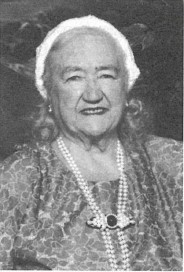
Elizabeth Blackwood
In Canmore Seniors at the Summit, ed. Canmore Seniors Association, 2000, p. 16-20.

